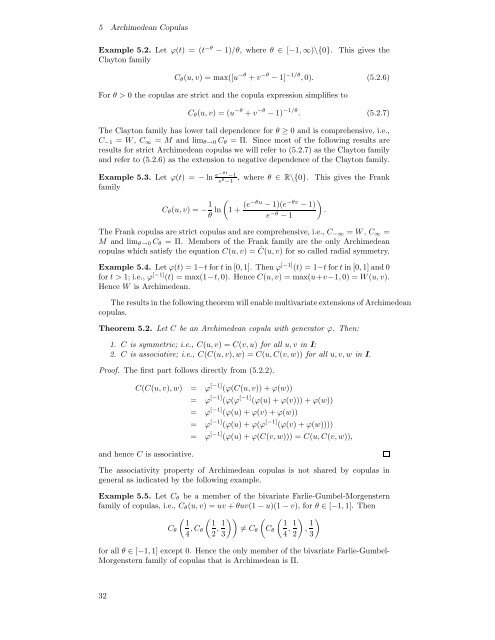Modelling Dependence with Copulas - IFOR
Modelling Dependence with Copulas - IFOR
Modelling Dependence with Copulas - IFOR
Create successful ePaper yourself
Turn your PDF publications into a flip-book with our unique Google optimized e-Paper software.
5 Archimedean <strong>Copulas</strong><br />
Example 5.2. Let ϕ(t) =(t −θ − 1)/θ, whereθ ∈ [−1, ∞)\{0}. This gives the<br />
Clayton family<br />
C θ (u, v) =max([u −θ + v −θ − 1] −1/θ , 0). (5.2.6)<br />
For θ>0 the copulas are strict and the copula expression simplifies to<br />
C θ (u, v) =(u −θ + v −θ − 1) −1/θ . (5.2.7)<br />
The Clayton family has lower tail dependence for θ ≥ 0 and is comprehensive, i.e.,<br />
C −1 = W , C ∞ = M and lim θ→0 C θ = Π. Since most of the following results are<br />
results for strict Archimedean copulas we will refer to (5.2.7) as the Clayton family<br />
and refer to (5.2.6) as the extension to negative dependence of the Clayton family.<br />
Example 5.3. Let ϕ(t) =− ln e−θt −1,whereθ ∈ R\{0}. This gives the Frank<br />
e θ −1<br />
family<br />
C θ (u, v) =− 1 (<br />
θ ln 1+ (e−θu − 1)(e −θv )<br />
− 1)<br />
e −θ .<br />
− 1<br />
The Frank copulas are strict copulas and are comprehensive, i.e., C −∞ = W , C ∞ =<br />
M and lim θ→0 C θ = Π. Members of the Frank family are the only Archimedean<br />
copulas which satisfy the equation C(u, v) =Ĉ(u, v) for so called radial symmetry.<br />
Example 5.4. Let ϕ(t) =1−t for t in [0, 1]. Then ϕ [−1] (t) =1−t for t in [0, 1] and 0<br />
for t>1; i.e., ϕ [−1] (t) =max(1−t, 0). Hence C(u, v) =max(u+v−1, 0) = W (u, v).<br />
Hence W is Archimedean.<br />
The results in the following theorem will enable multivariate extensions of Archimedean<br />
copulas.<br />
Theorem 5.2. Let C be an Archimedean copula <strong>with</strong> generator ϕ. Then:<br />
1. C is symmetric; i.e., C(u, v) =C(v, u) for all u, v in I;<br />
2. C is associative; i.e., C(C(u, v),w)=C(u, C(v, w)) for all u, v, w in I.<br />
Proof. The first part follows directly from (5.2.2).<br />
C(C(u, v),w) = ϕ [−1] (ϕ(C(u, v)) + ϕ(w))<br />
= ϕ [−1] (ϕ(ϕ [−1] (ϕ(u)+ϕ(v))) + ϕ(w))<br />
= ϕ [−1] (ϕ(u)+ϕ(v)+ϕ(w))<br />
= ϕ [−1] (ϕ(u)+ϕ(ϕ [−1] (ϕ(v)+ϕ(w))))<br />
= ϕ [−1] (ϕ(u)+ϕ(C(v, w))) = C(u, C(v, w)),<br />
and hence C is associative.<br />
The associativity property of Archimedean copulas is not shared by copulas in<br />
general as indicated by the following example.<br />
Example 5.5. Let C θ be a member of the bivariate Farlie-Gumbel-Morgenstern<br />
family of copulas, i.e., C θ (u, v) =uv + θuv(1 − u)(1 − v), for θ ∈ [−1, 1]. Then<br />
( ( 1 1<br />
C θ<br />
4 ,C θ<br />
2 , 1 ( ( 1<br />
≠ C θ C θ<br />
3))<br />
4 , 1 )<br />
, 1 )<br />
2 3<br />
for all θ ∈ [−1, 1] except 0. Hence the only member of the bivariate Farlie-Gumbel-<br />
Morgenstern family of copulas that is Archimedean is Π.<br />
32
















